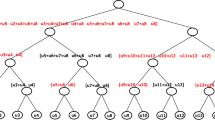Abstract
Recently, a Maximum Entropy (MaxEnt) algorithm and its derivation called WNEW algorithm were presented by the same author. It was shown that the MaxEnt and WNEW algorithm have improved equalization performance compared with Godard’s, reduced constellation algorithm and the sign reduced constellation algorithm. In this paper, a new equalization method is proposed for the 16QAM and 64QAM input constellation based on the WNEW algorithm which is extended with some polynomials of the equalized output and optimized with the mean square error criteria. According to simulation results, the new equalization method leads to over 15 dB advantage in the residual Intersymbol Interference compared to the results presented by Godard, 10 dB advantage compared with the WNEW algorithm and 5 dB advantage compared with the MaxEnt algorithm.
Similar content being viewed by others
References
Nikias, C.L., Petropulu, A.P. (eds.): Higher-Order Spectra Analysis A Nonlinear Signal Processing Framework, chap. 9, pp. 419–425. Prentice-Hall, Englewood Cliffs (1993)
Godard D.N.: Self recovering equalization and carrier tracking in two-dimenional data communication system. IEEE Trans. Commun. 28(11), 1867–1875 (1980)
Sato Y.: A method of self-recovering equalization for multilevel amplitude-modulation systems. IEEE Trans. Commun. 23, 679–682 (1975)
Bellini, S.: Bussgang techniques for blind equalization. In: IEEE Global Telecommunication Conference Records, pp. 1634–1640, December (1986)
Bellini S.: Blind equalization. Alta Frequenza 57, 445–450 (1988)
Pinchas M., Bobrovsky B.Z.: A maximum entropy approach for blind deconvolution. Signal Process. (Eurasip) 86(10), 2913–2931 (2006)
Haykin, S.: Blind deconvolution. In: Haykin, S. (ed.) Adaptive Filter Theory, chap. 20. Prentice-Hall, Englewood Cliffs (1991)
Gitlin, R.D., Hayes, J.F., Weinstein, S.B.: Automatic and Adaptive Equalization, Data Communications Principles, chap. 8, pp. 587–590. Plenum, New York (1992)
Im G.-H., Park C.J., Won H.C.: A blind equalization with the sign algorithm for broadband access. IEEE Comm. Lett. 5(2), 70–72 (2001)
Fiori S.: A contribution to (neuromorphic) blind deconvolution by flexible approximated Bayesian estimation. Signal Process. (Eurasip) 81, 2131–2153 (2001)
Lazaro M., Santamaria I., Erdogmus D., Hild K.E., Pantaleon C., Principe J.C.: Stochastic blind equalization based on pdf fitting using parzen estimator. IEEE Trans. Signal Process. 53(2), 696–704 (2005)
Shalvi O., Weinstein E.: New criteria for blind deconvolution of nonminimum phase systems (channels). IEEE Trans. Inform. Theory 36(2), 312–321 (1990)
Shalvi O., Weinstein E.: Super-exponential methods for blind deconvolution. IEEE Trans. Inform. Theory 39(2), 312–321 (1993)
Benveniste A., Goursat M.: Blind equalizers. IEEE Trans. Commun. 32, 871–883 (1984)
Nandi, A.K. (ed.): Blind Estimation Using Higher-Order Statistics, chap. 2, p. 66. Kluwer, Boston (1999)
Author information
Authors and Affiliations
Corresponding author
Rights and permissions
About this article
Cite this article
Pinchas, M. A MSE optimized polynomial equalizer for 16QAM and 64QAM constellation. SIViP 5, 29–37 (2011). https://doi.org/10.1007/s11760-009-0138-z
Received:
Revised:
Accepted:
Published:
Issue Date:
DOI: https://doi.org/10.1007/s11760-009-0138-z




